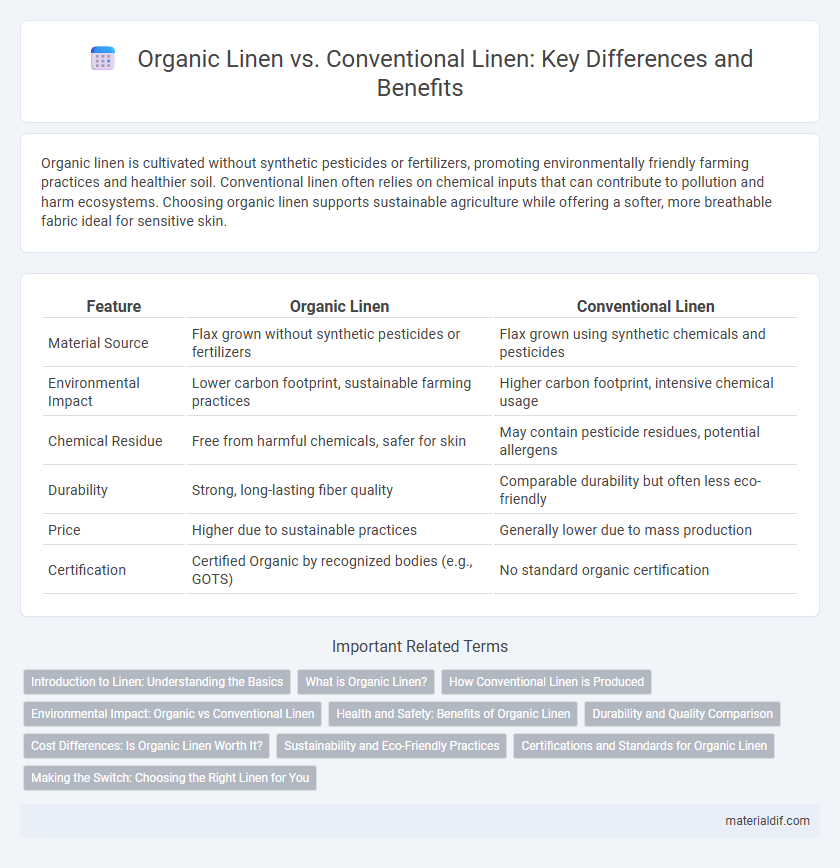Organic linen is cultivated without synthetic pesticides or fertilizers, promoting environmentally friendly farming practices and healthier soil. Conventional linen often relies on chemical inputs that can contribute to pollution and harm ecosystems. Choosing organic linen supports sustainable agriculture while offering a softer, more breathable fabric ideal for sensitive skin.
Table of Comparison
| Feature | Organic Linen | Conventional Linen |
|---|---|---|
| Material Source | Flax grown without synthetic pesticides or fertilizers | Flax grown using synthetic chemicals and pesticides |
| Environmental Impact | Lower carbon footprint, sustainable farming practices | Higher carbon footprint, intensive chemical usage |
| Chemical Residue | Free from harmful chemicals, safer for skin | May contain pesticide residues, potential allergens |
| Durability | Strong, long-lasting fiber quality | Comparable durability but often less eco-friendly |
| Price | Higher due to sustainable practices | Generally lower due to mass production |
| Certification | Certified Organic by recognized bodies (e.g., GOTS) | No standard organic certification |
Introduction to Linen: Understanding the Basics
Organic linen is cultivated without synthetic pesticides or fertilizers, promoting environmentally sustainable farming practices that enhance soil health and reduce chemical runoff. Conventional linen, on the other hand, relies on traditional agricultural methods involving chemical interventions that can harm ecosystems and compromise textile purity. Understanding these differences helps consumers make informed choices about the environmental impact and quality of their linen products.
What is Organic Linen?
Organic linen is made from flax plants grown without synthetic pesticides, herbicides, or chemical fertilizers, ensuring an eco-friendly and sustainable cultivation process. The fibers are harvested and processed using natural methods that avoid harmful bleaching agents and toxic dyes, preserving the fabric's purity and biodegradability. Compared to conventional linen, organic linen offers enhanced environmental benefits, including reduced soil degradation, lower water consumption, and minimized chemical runoff.
How Conventional Linen is Produced
Conventional linen is produced using traditional farming methods that rely heavily on chemical fertilizers and pesticides to maximize flax crop yields. These chemicals can lead to soil degradation and environmental pollution, affecting biodiversity and water quality. The retting process in conventional linen production often uses water-based techniques that may release pollutants if not properly managed.
Environmental Impact: Organic vs Conventional Linen
Organic linen cultivation minimizes environmental impact by utilizing natural pest control methods and avoiding synthetic fertilizers, resulting in healthier soil and reduced water contamination. Conventional linen farming often relies on chemical pesticides and fertilizers, contributing to soil degradation and water pollution. The sustainable practices in organic linen production lead to lower carbon emissions and a smaller ecological footprint compared to conventional linen.
Health and Safety: Benefits of Organic Linen
Organic linen is cultivated without synthetic pesticides or fertilizers, reducing exposure to harmful chemicals that can irritate sensitive skin or cause allergic reactions. Its natural cultivation process promotes healthier indoor air quality by minimizing toxic residues often found in conventional linen. Choosing organic linen supports safer, hypoallergenic bedding and clothing options that protect both personal health and the environment.
Durability and Quality Comparison
Organic linen is cultivated without synthetic chemicals, resulting in fibers that maintain strength and resilience through natural growth, often leading to enhanced durability compared to conventional linen. Conventional linen may involve pesticides and fertilizers that can weaken the fiber structure over time, potentially reducing longevity and quality. Numerous studies indicate organic linen fabrics typically exhibit higher durability and a softer texture, contributing to superior overall fabric quality.
Cost Differences: Is Organic Linen Worth It?
Organic linen typically costs 20-50% more than conventional linen due to sustainable farming practices and certification expenses. Despite higher prices, organic linen offers benefits like reduced chemical exposure and environmental impact, making it a valuable investment for eco-conscious consumers. The long-term durability and eco-friendly production processes often justify the premium for those prioritizing sustainability and health.
Sustainability and Eco-Friendly Practices
Organic linen is produced from flax grown without synthetic pesticides or fertilizers, significantly reducing environmental pollution and promoting soil health. Conventional linen cultivation often relies on chemical inputs that can lead to soil degradation and water contamination. Choosing organic linen supports sustainable farming practices, lowers carbon footprints, and conserves biodiversity compared to conventional methods.
Certifications and Standards for Organic Linen
Organic linen is distinguished by certifications such as GOTS (Global Organic Textile Standard) and OEKO-TEX Standard 100, which ensure the fabric is produced without harmful chemicals and meets strict environmental and social criteria. These certifications verify that organic linen fibers are grown using sustainable farming practices, avoiding synthetic pesticides and fertilizers found in conventional linen production. Adhering to these standards guarantees a safer, eco-friendly textile that supports biodiversity and soil health.
Making the Switch: Choosing the Right Linen for You
Choosing between organic linen and conventional linen involves evaluating environmental impact, chemical use, and durability. Organic linen is cultivated without synthetic pesticides or fertilizers, reducing harm to ecosystems and promoting sustainable agriculture. Conventional linen, while widely available and often more affordable, may involve chemicals that affect soil health and water quality, making organic linen a preferable choice for eco-conscious consumers seeking sustainable and high-quality textile options.
Organic Linen vs Conventional Linen Infographic

 materialdif.com
materialdif.com